Posted by Anita on 05.05.08 10:19 PM
 The San Francisco cocktail circuit is a pretty cozy scene. It’s not just that bartenders pick up shifts at three or four different bars or restaurants in as many nights, although that helps. It’s more that for some reason, every now and then, a somewhat obscure cocktail will simultaneously capture the imaginations of multiple menu-writers. Suddenly you see the darned thing everywhere.
The San Francisco cocktail circuit is a pretty cozy scene. It’s not just that bartenders pick up shifts at three or four different bars or restaurants in as many nights, although that helps. It’s more that for some reason, every now and then, a somewhat obscure cocktail will simultaneously capture the imaginations of multiple menu-writers. Suddenly you see the darned thing everywhere.
Last fall, the cocktail of the moment was the Dark n’ Stormy; every watering hole in The City had it on their menu, and pretty soon Gosling’s Black Seal was a common sight on the speedrail. The effect is so pervasive it feels like one of those community reading programs where everyone skims the same hardback on the subway, except here in SF, it’s “One City, One Drink“.
Winter’s finally over, and so the ginger beer, sadly, is making its way back to the cellar. But ready to take its place, you’ll find a slew of imported, artisanal, and home-brewed grapefruit sodas. Paired with a healthy glug of reposado tequila, a pinch of salt, and the juice of half a lime, you’ve got yourself a Mexican fiesta in a glass, that lazy-man’s margarita known as the Paloma.
Of course, it wouldn’t be San Francisco without some liberties taken. Over at the Chronicle, our pal Jane details three different SF bars offering their own twists on the Paloma. Alembic uses homemade soda and some spicy secret ingredient; newcomer Beretta adds elderflower and Cointreau… hmm. I’m sure they’re lovely, but honestly (and here’s something you won’t hear me saying often) I’m pretty sure I’d rather try my luck at Tres Agaves. Their straight-ahead, old-school version uses Jarritos soda, which — after sampling Squirt, Hansens, and Fresca — I’m going to say is an essential ingredient. So please, hit up your local bodega or taqueria, and look for the bottle marked “toronja”.
My one deviation from the Paloma recipe you’ll find at beachfront cantinas up and down the Baja coast is a good shake of Fee Brothers’ Grapefruit Bitters. They’re optional, of course… but they add a delightful boost of grapefruit-peel flavor and accentuate the spicy tequila bite.
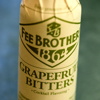
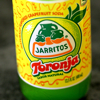
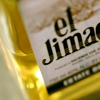


Paloma
2oz reposado tequila
juice of 1/2 lime
Mexican grapefruit soda, such as Jarritos
a hearty dash of grapefruit or orange bitters (optional, but delicious)
table salt (not kosher)
Combine the tequila and lime juice in an ice-filled highball glass. Fill with grapefruit soda, then top the ice with a shake of bitters and a healthy shake of salt.
bar culture, Drink of the Week, drinks, Mexican, recipes
14 Comments »




Posted by Anita on 05.04.08 11:30 PM
 Â A few years ago on May 5, I found myself in Puebla — the city where the historic Cinco de Mayo victory of Mexican forces over their French invaders took place. When I asked my taxi driver if there were any festivities planned to commemorate the anniversary, he looked at me like I was crazy: “It’s a military holiday, mija.”
 A few years ago on May 5, I found myself in Puebla — the city where the historic Cinco de Mayo victory of Mexican forces over their French invaders took place. When I asked my taxi driver if there were any festivities planned to commemorate the anniversary, he looked at me like I was crazy: “It’s a military holiday, mija.”
Even in Puebla, the idea of Cinco de Mayo as an event worthy of feasting and celebration seemed utterly unknown. Every Poblano who I told of the norteamericano version of the holiday — at best a celebration of Mexican-American pride, at worst an excuse to drink excessive quantities of nasty sour-mix Margaritas — expressed complete astonishment, shaking their heads as though they’d just discovered yet another reason to pity our confused country.
But no matter: I hadn’t gone to Puebla in search of patriotic parades or folklorico dancing in the city squares. I’d gone there to spend a few days relaxing before meeting friends in the bustle of Mexico City, to explore the city’s beautiful colonial architecture, and to eat Puebla’s famously delicious food.
Strolling the streets the morning of my arrival, I found a peasant woman standing in a tiny off-the-path plaza, selling tamales out of a steaming metal can. There were three choices, but I barely registered the first two: The last, the one I chose, was mole. There are many moles in Mexico of course, but the best-known — the chocolate-tinged, brick-red one most Americans think of when they think of mole — hails from Puebla. Reputedly invented by an order of nuns in honor of their bishop’s visit, mole poblano is sinfully delicious and worth every bit of the hassle it takes to make it. It also makes an excellent tamale filling, a perfect breakfast after 12 hours of travel by plane and bus and taxi.
Thus fortified, I wandered Puebla’s tidy grid of streets without much of a plan. I explored the cathedral of the angels, considered one of the country’s most stunning churches, followed by a plate of tacos árabes at a tile-bright shop called Tacos Tony. I watched the propane vendors ply their wares: Pulling their truck up to the middle of a residential block, they blared their promotional jingle — a festive snippet of dance music, punctuated by a deep bass voice crying “EL GAZ!!” — and the ladies of the house would come to the street bearing tanks to be filled. On my way to the Mercado Carranza, I stumbled across a Victorian-era shopping arcade featuring an enormous stained-glass gazebo and cobblestone footpaths. And once I reached the mercado, I discovered my favorite Puebla snack: Cemitas, at a stand called El As de Oros.
Some folks will tell you that a cemita is little more than a torta served on a Puebla-style roll rather than a more typical bolillo, but the differences run a little deeper. Like tortas, cemitas are available with the diner’s choice of meat fillings — stew-like tinga, crispy carnitas, chewy cueritos, or golden-brown milanesa. And like tortas, cemitas are essentially a taco on a bun.
Unlike a torta, though, you rarely see mayonnaise on a cemita, nor frijoles; lettuce is a definite no-no. Aside from the meat, toppings nearly always include a generous amount of avocado, a bouncy cheese like panela or queso de Oaxaca, a slather of salsa roja, and a pungent herb called papalo. Like tacos árabes, cemitas have their roots in the cuisine of Puebla’s Lebanese immigrants. The word itself means “semite”, a nod to the soft, eggy, sesame-seeded rolls borrowed from the Arabic kitchen.
Alas, unlike in Los Angeles — where a gaggle of cemita trucks are giving their taco-vending cousins a serious run for the money — you’d be hard pressed to find a cemita for sale in San Francisco. But of all the comidas tÃpicas poblanas, cemitas are the easiest to make. Even if you quake at the thought of a day-long adventure required to make authentic mole poblano, or the near-impossible task of replicating spit-grilled tacos árabes at home, cemitas are a cinch.
The ones we’re enjoying as our Cinco de Mayo treat are filled with the homemade chicken-fried-steak called milanesa, arguably the most-popular cemita filling. But if you’ve got some carnitas or tinga left over from your own festivities, I guarantee they’ll find a happy home between two halves of a sesame-seed bun.

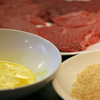


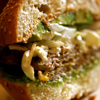
Cemitas Poblanas de Milanesa
1 pound beef sirloin tips, pounded thin
1/2 cup flour, seasoned with 2tsp salt and 1tsp pepper
1 egg, well scrambled with 1T water
1/2 cup fine breadcrumbs
oil for frying
—–
4 challah rolls, preferrably sesame seeded
1 mild white or red onion, sliced thickly
8 oz panela or queso de Oaxaca, or other fresh and creamy Mexican cheese
your favorite mexican salsa roja (the cooked smooth sort, not like pico de gallo)
– or substitute a few pureed chiles chipotles en adobo thinned with water or vinegar
2 large avocados, peeled and sliced
16 sprigs of papalo (or substitute cilantro)
Pound the meat flat with a meat tenderizer, 1/4-inch or thinner, and pat dry with a paper towel. If the pieces are larger than sandwich size, you may want to cut them apart. Dredge the meat in the seasoned flour, brushing off any excess until just the thinnest layer remains. Dip quickly in the egg, again taking care to leave as little as possible on the meat, and then a light layer of breadcrumbs.
In a deep skillet, add sufficient oil to shallow-fry at a depth of 1/4 inch. (In my 10-inch skillet, I used about 3/4 cup.) Heat the pan over medium heat until oil is shimmering but not smoking. Place the breaded meat in the pan and fry until golden brown on both sides, just a few minutes total. Remove from the pan and keep warm on a cooling rack in a warm oven.
Cut the buns in half, and lightly toast under a broiler or on a griddle. While buns are toasting, coarsely smash 1/3 of the avocado in a bowl with the back of a fork. Spread the mashed avocado on the bottom of each bun, and season with salt. Pour the salsa onto a small saucer, and dip the top half of each bun into the salsa to coat; set aside. Top the bottom half of the bun with a piece of the milanesa, followed by cheese, onions, papalo or cilantro, and the remaining sliced avocados, and the salsa-smeared top.
Something to drink?
– Margaritas: Drink of the Week 9/15/06
– Michelada: Drink of the Week 11/24/06
– Sangrita: Drink of the Week 6/1/07
holidays & occasions, meat, Mexican, travel
3 Comments »




Posted by Anita on 03.16.08 10:01 AM
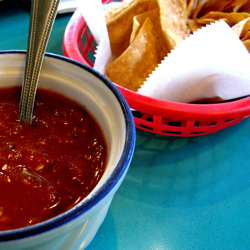 My Dark Days Challenge cohorts, please avert your eyes: With the exception of two or three breakfasts, there was absolutely nothing sustainable, local, or even organic about the way we spent our long Presidents Day weekend. Que lastima — we traded local for loco, spending a crazy four days eating nothing but Mexican food.
My Dark Days Challenge cohorts, please avert your eyes: With the exception of two or three breakfasts, there was absolutely nothing sustainable, local, or even organic about the way we spent our long Presidents Day weekend. Que lastima — we traded local for loco, spending a crazy four days eating nothing but Mexican food.
Since time was limited on Friday morning before work, we headed to an old standby. Los Jarritos has been the scene of more Sunday breakfasts than we can count, and one or two dinners over the years. The coffee is terrible, so stick with the Mexican chocolate, and the chilaquiles are limp and over-egged. But it’s hard to complain too much about a place that serves homemade tortillas, and the service is always so adorably welcoming that we’re more than a little forgiving of Jarritos’ shortcomings.
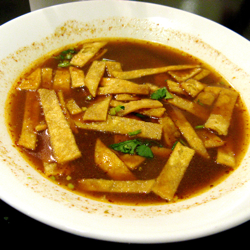 Maybe it’s was a case of diminished expectations, but I have to say that my lunch at Frontera Fresco on the lower level of Macy’s Union Square was not nearly the dreck-fest I was expecting after reading some early critiques. Yes, it’s corporate chain food — think Wolfgang Puck Express goes to Mexico — but it’s certainly no travesty.
Maybe it’s was a case of diminished expectations, but I have to say that my lunch at Frontera Fresco on the lower level of Macy’s Union Square was not nearly the dreck-fest I was expecting after reading some early critiques. Yes, it’s corporate chain food — think Wolfgang Puck Express goes to Mexico — but it’s certainly no travesty.
It might be too strong to say that I enjoyed my meal, but I was served a thoroughly decent, well-garnished bowl of tortilla soup, and an unorthodox (but not unpleasant) chicken torta. I laughed out loud at the sandwich’s sundried tomato garnish, and its lettuce seemed to be dressed in Good Seasons Zesty Italian. But everything else was in the ballpark: rich frijoles, tinga-style chicken, and a chunky slab of queso añejo. Don’t get me wrong: It’s not fabulous, and it’s definitely not worth a special trip, but there are certainly worse ways to spend your $10 downtown. And I’d be downright ecstatic to find a Frontera Fresco branch in an airport.
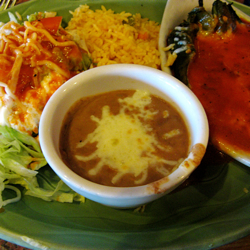 Friday afternoon, I hopped a southbound CalTrain after work. Cameron picked me up at Mountain View station and in just a few moments we were pulling into the parking lot of our favorite Mexican restaurant, Fiesta del Mar. Our friends Jason and Margaret introduced us to this fabulous place way back in the day — more than a decade ago, now — and we’ve been coming here religiously ever since. Sure it’s crazy to drive an hour to go to dinner, but such is our devotion.
Friday afternoon, I hopped a southbound CalTrain after work. Cameron picked me up at Mountain View station and in just a few moments we were pulling into the parking lot of our favorite Mexican restaurant, Fiesta del Mar. Our friends Jason and Margaret introduced us to this fabulous place way back in the day — more than a decade ago, now — and we’ve been coming here religiously ever since. Sure it’s crazy to drive an hour to go to dinner, but such is our devotion.
And we’re not the only fans: Plaques on the wall attest to the restaurant’s enduring popularity: They’ve been voted “Best Mexican Restaurant” by the local paper every year but one since the early 1990s. They’re justly famous for their shrimp dishes — Cameron loves their Camarones Alex and the Camarones a la Diabla — but I love them for their great margaritas (El Jimador, rocks, salt… thanks!) and their unbattered chiles rellenos. There’s almost always a line out the door, but the tables turn quickly and you won’t regret the wait.
 Saturday morning found us at our usual spot: The Ferry Plaza farmers market, and specifically the Primavera stand. Although this market favorite offers chilaquiles nearly every Saturday, they mix things up a little by varying the sauce; one week it’s a green tomatillo-serrano blend, the next it’s a tomato-chipotle salsa, and the next it might be a puree of guajillo chiles (as it was that weekend).
Saturday morning found us at our usual spot: The Ferry Plaza farmers market, and specifically the Primavera stand. Although this market favorite offers chilaquiles nearly every Saturday, they mix things up a little by varying the sauce; one week it’s a green tomatillo-serrano blend, the next it’s a tomato-chipotle salsa, and the next it might be a puree of guajillo chiles (as it was that weekend).
A plate of salsa-sauteed chips served with Cameron’s all-time favorite soft-scrambled eggs and some pretty delicious black beans… ahh, brunchly perfection. Of course, we couldn’t resist ordering a plate of tacos al pastor — and its perfect pairing, piña agua fresca. Weighted down by our mega-breakfast, we wandered our way around the market, vainly trying to work off our stuffedness while finishing our weekly shopping.
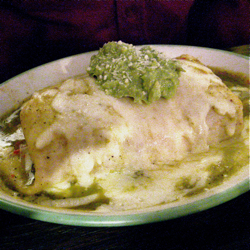 Not surprisingly, we weren’t hungry again until dinnertime. After the sun set, we made our way to the Daly City border to check out a little hole-in-the-wall we’d heard good things about. Lisa’s Mexican Restaurant looks like a biker bar from the outside, with its microscopic windows, spotlit sign, and ugly burglary bars facing Mission Street.
Not surprisingly, we weren’t hungry again until dinnertime. After the sun set, we made our way to the Daly City border to check out a little hole-in-the-wall we’d heard good things about. Lisa’s Mexican Restaurant looks like a biker bar from the outside, with its microscopic windows, spotlit sign, and ugly burglary bars facing Mission Street.
But when you step inside, you’re entering another world. Every surface but the floor is covered with goofy stuff — photos of old Mexican movie stars, life-size parrots, oversized sombreros, and creepy paintings of big-eyed children. The overall effect is like dining inside some crazy abuela’s closet, but somehow it feels cozy, not chaotic. The welcome is friendly, both from the staff and the other patrons. And the food…
Well, honestly, I don’t want to get your hopes up. Lisa’s is decidedly not gourmet, and it definitely isn’t in the same league as Fiesta del Mar. But if you’re a homesick Southern Californian pining for the cheesy combo-plates of your youth, Lisa’s will fill your heart and belly in a way that you’ve never experienced north of the Grapevine. Their chile relleno sauce is just right (it’s the kind with chunks of celery like you see absolutely everywhere in L.A.) and their crispy tacos are dynamite. The best thing we’ve had at Lisa’s — and I am embarrassed to admit, we’ve been back almost every week since we discovered it – is their chile verde. Cameron likes to ask for it in their Lisa’s Especial, a football-sized ‘wet’ burrito stuffed with everything a homesick Angeleño needs to feel right again.
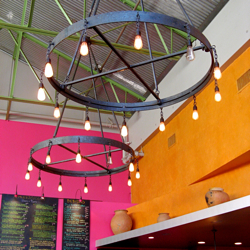 Sunday we crossed the bridge for brunch at our East Bay fave, Tacubaya. The spinoff of Temescal’s oft-lauded Doña Tomás, this taqueria — tucked behind Sur La Table and Café Rouge on Berkeley’s Fourth Street restaurant row — lures breakfasters into gorgeous skylit space decked out in tropical-fruit colors and natural wood surfaces. It’s a neighborly place, albeit one with a very calculated and upscale vibe, and though the crowds come out in force, the line moves fast and there’s never much of a wait for a table.
Sunday we crossed the bridge for brunch at our East Bay fave, Tacubaya. The spinoff of Temescal’s oft-lauded Doña Tomás, this taqueria — tucked behind Sur La Table and Café Rouge on Berkeley’s Fourth Street restaurant row — lures breakfasters into gorgeous skylit space decked out in tropical-fruit colors and natural wood surfaces. It’s a neighborly place, albeit one with a very calculated and upscale vibe, and though the crowds come out in force, the line moves fast and there’s never much of a wait for a table.
No matter what time of day we visit, we can never resist an order of churros y chocolate; other breakfast fare mostly starts and stops with so-so chilaquiles and decent variations on huevos, plus menudo on weekends. Like its O-Town sibling, Tacubaya bases its menu on local produce and sustainable meat.
 Later in the day, we took a long-overdue tour of Oakland’s taco-truck scene. We used to love planning day-long taco crawls with our Seattle crew, and when we first moved back to San Francisco, we tried to get our new friends to follow suit. Various circumstances conspired against us — ranging from a surreal bout of foul weather to half the group catching one of those pandemic colds — and eventually we gave up trying to get everyone across the bay at the same time. But I’d kept my notes, adding a truck here or a cart there from time to time, and waited for the right day. And now that day had come.
Later in the day, we took a long-overdue tour of Oakland’s taco-truck scene. We used to love planning day-long taco crawls with our Seattle crew, and when we first moved back to San Francisco, we tried to get our new friends to follow suit. Various circumstances conspired against us — ranging from a surreal bout of foul weather to half the group catching one of those pandemic colds — and eventually we gave up trying to get everyone across the bay at the same time. But I’d kept my notes, adding a truck here or a cart there from time to time, and waited for the right day. And now that day had come.
We started out at the corner of 22nd and International, at a former A&W Drive-In that’s now home to not one but two taco trucks. Tacos Sinaloa features the usual assortment of meats — carnitas, chorizo, carne asada, and such — ensconsed in the eater’s choice of tacos, burritos, tortas and more. Across the parking lot, Mariscos Sinaloa offers all these plus fish tacos, tostadas de ceviche, and other seafood-based items. I opted for a taco full of deliciously meaty carnitas; Cameron had a muy sabroso shrimp taco from the other truck. Off to a good start, we ate our way up and down the boulevard, stopping at any truck where we saw more than two people in line. Our favorites: El Grullo’s tacos al pastor, Tacos Guadalajara’s shredded carnitas, and the cabeza at El Novillo in the shadow of Fruitvale BART.
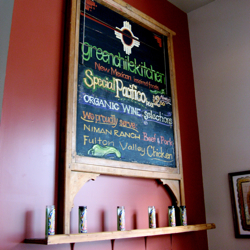 Monday is a hard day to find Mexican breakfast in the City; many family-run businesses take the day off after their weekend rush. We didn’t want to repeat ourselves, so we headed to Green Chile Kitchen over in NoPa. It’s the kind of storefront cafe you find in nearly every San Francisco neighborhood: Wood tables, tall windows, a chalkboard menu, and a tall counter where you place your order.
Monday is a hard day to find Mexican breakfast in the City; many family-run businesses take the day off after their weekend rush. We didn’t want to repeat ourselves, so we headed to Green Chile Kitchen over in NoPa. It’s the kind of storefront cafe you find in nearly every San Francisco neighborhood: Wood tables, tall windows, a chalkboard menu, and a tall counter where you place your order.
Sadly, the food’s no better than average, and it’s definitely Southwestern rather than Mexican. But they use quality ingredients (mostly organic produce, Niman Ranch meats, and Fulton Valley chicken) and there’s good coffee, easy street parking, and a pleasant little vibe.
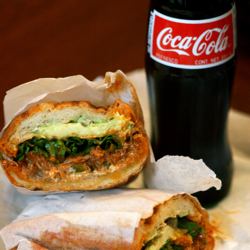 As we were leaving NoPa, the once-cloudy day turned sunny, so we grabbed the dogs and headed back to the Mission. There’s nothing better on a bright winter afternoon than a lazy meander down the eastern stretch of 24th Street, where you can walk and shop for hours without hearing a single word of English. When we’d finally gotten our appetites back, Cameron entertained the pups while I popped into Tortas Los Picudos, a cheerful slice of chaos where they sell grilled Mexican sandwiches and licuados (which many shops translate as “milkshakes” although they’re really more like smoothies).
As we were leaving NoPa, the once-cloudy day turned sunny, so we grabbed the dogs and headed back to the Mission. There’s nothing better on a bright winter afternoon than a lazy meander down the eastern stretch of 24th Street, where you can walk and shop for hours without hearing a single word of English. When we’d finally gotten our appetites back, Cameron entertained the pups while I popped into Tortas Los Picudos, a cheerful slice of chaos where they sell grilled Mexican sandwiches and licuados (which many shops translate as “milkshakes” although they’re really more like smoothies).
Fillings at Los Picudos run the gamut from basic ham-and-American or turkey-and-Swiss to belly busters like the Cubana. A very distant relation to the medianoche you may be used to, Los Picudos’ porcine homage to La Isla includes roast pork, ham, queso fresco, lettuce, jalapeños, mayonnaise, butter… and a foot-long hotdog! We wisely chose to split a spicy pulled-pork torta, and picked up a Mexican Coke at Casa Lucas on our way back up the block.
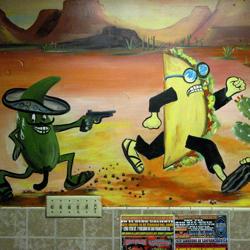 By the time we were hungry again, our options on a Monday night had diminished to a handful of late-night taquerias. Wanting to make sure we ended our weekend of gluttony on a high note, we popped down the hill to our nearby favorite, El Gran Taco Loco. Sandwiched in between a hard-liver bar and our local branch of Cole Hardware, Taco Loco has won our hearts despite its interrogation-room lighting, uncomfortable booths, and goofball murals.
By the time we were hungry again, our options on a Monday night had diminished to a handful of late-night taquerias. Wanting to make sure we ended our weekend of gluttony on a high note, we popped down the hill to our nearby favorite, El Gran Taco Loco. Sandwiched in between a hard-liver bar and our local branch of Cole Hardware, Taco Loco has won our hearts despite its interrogation-room lighting, uncomfortable booths, and goofball murals.
We long ago discovered that the burritos and other semi-Americanized offerings at Taco Loco aren’t much to write home about, but their tacos — and most specifically, their carnitas tacos — are a thing of beauty and a joy forever. (Or at least the next 4 to 6 hours.) Cameron’s a huge fan of their birria, — a goaty, dark-chile-flavored soup that’s good for whatever ails you on a Sunday morning. But for our last meal of the long weekend, we kept it simple: A carnitas super-taco for me, and a buche taco for the bald guy. It certainly wasn’t the best meal of the bunch, but a late-night snack at our neighborhood favorite was definitely a fitting end to a gastronomical journey that spanned three area codes.
Los Jarritos
901 South Van Ness
San Francisco, CA 94110
415 648.8383
Frontera Fresco
170 O’Farrell Street, Macy’s basement level
San Francisco, CA 94103
415 296.4349
Fiesta del Mar
1005 N. Shoreline Blvd
Mountain View CA 94043
650 965.9354
Primavera
Ferry Plaza Farmers Market (Embarcadero at Market)
San Francisco, CA
Lisa’s Mexican Restaurant
6582 Mission Street (near John Daly Blvd)
Daly City, CA 94014
650 756.6289
Tacubaya
1788 4th Street
Berkeley, CA 94710
510 525.5160
Tacos Sinaloa / Mariscos Sinaloa
International Blvd & 22nd Avenue
Oakland, CA 94601
El Grullo
International Blvd & 26th Avenue
Oakland, CA 94601
Tacos Guadalajara
International Blvd & 44th Avenue
Oakland, CA 94601
Tacos El Novillo
1001 Fruitvale Avenue
Oakland, CA 94610
Green Chile Kitchen
601 Baker Street
San Francisco, CA 94117
415 614.9411
Tortas Los Picudos
2969 24th Street
San Francisco, CA 94110
415 824.4199
El Gran Taco Loco
3306 Mission Street
San Francisco, CA 94110
415 695.0621
breakfast, downtown SF, East Bay, Mexican, restaurants, The Mission
12 Comments »




Posted by Anita on 12.26.07 12:45 PM
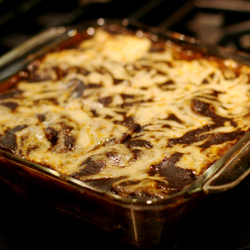 Getting the house — and the fridge — ready for our 10-day Christmas absence was an enormous pain in the ass. Truthfully, I enjoy the puzzle of combining fresh food and freezer fodder to make reasonably coherent meals, but sometimes this happens at the expense of our 90%-local Dark Days Challenge goal.
Getting the house — and the fridge — ready for our 10-day Christmas absence was an enormous pain in the ass. Truthfully, I enjoy the puzzle of combining fresh food and freezer fodder to make reasonably coherent meals, but sometimes this happens at the expense of our 90%-local Dark Days Challenge goal.
A case in point: We needed to use up tortillas (local), beans (ditto) and salsa (yep), plus an assortment of cheeses (likewise) — a natural set of ingredients for BudÃn Azteca, a.k.a. tortilla pie. So we defrosted the last of the local Thanksgiving turkey… and a decidedly non-local batch of mole sauce. We could say that the chiles qualify as seasonings and the chocolate’s a baking supply — both of which are exempt from the challenge. But given that we made and froze this sauce early last spring, long before even our first stab at locavorism, that seems a bit far-fetched.
 Our second attempt was less of a stretch. With a half-jar of home-canned tomatoes, a few strips of Fatted Calf pancetta, half a ball of Belfiore mozzarella, and a handful of Far West mushrooms, we had all the makings of a couple of pizzas. We’ll overlook that the frozen pizza dough was made months ago with non-local flour (it’s still an exemption, after all, even if we have found some local sources for grains). Add a salad of Star Route Farms romaine, radicchio, and radishes, and we could call this our first true 90% meal of the week.
Our second attempt was less of a stretch. With a half-jar of home-canned tomatoes, a few strips of Fatted Calf pancetta, half a ball of Belfiore mozzarella, and a handful of Far West mushrooms, we had all the makings of a couple of pizzas. We’ll overlook that the frozen pizza dough was made months ago with non-local flour (it’s still an exemption, after all, even if we have found some local sources for grains). Add a salad of Star Route Farms romaine, radicchio, and radishes, and we could call this our first true 90% meal of the week.
Hitting the mark without a single cheat, Tuesday night’s steak dinner featured Prather Ranch ribeye, an assortment of stray Little’s potatoes mashed with Straus cream and Clover butter, and another big salad, this one dressed with Point Reyes Blue and Bariani olive oil. Yum. Friday’s pasta night was another clean sweep: Our usual Bolognese sauce over Eduardo’s, a carrot-and-radish-topped salad, and garlic toast made from the heels of our Acme pain de mie loaf.
All in all, not a bad week of local eating, given everything else that we had going on.
It’s been a while since we’ve added any new local products to our pantry, but we discovered not just one variety but a whole assortment of dried chiles at the Tierra Vegetables stand at the Ferry Plaza market. Maybe, just maybe, the next time we pop a package of mole out of the freezer, we won’t be fudging at all.


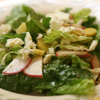
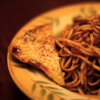

BudÃn Azteca
1 to 2 cups shredded chicken or turkey
1/2 to 1 cup prepared salsa
6 to 8 corn tortillas
2 cups mashed black or pinto beans
2 cups mole (recipe follows)
1/2 cup chicken stock, plus more as needed
2 cups shredded melting cheese, such as Jack or mozzarella
sour cream, sliced radishes, and cilantro for garnish
Preheat oven to 350°F.
In a saucepan, warm the beans over medium-low heat, thinning with chicken stock or water to a spreadable consistency.
In a separate pan, warm the meat with the salsa.
In a third pan, heat the molé, thinning with 1/2 cup or more of chicken stock, to a tomato-sauce consistency.
Heat the tortillas in a skillet or over an open flame. Cut each tortilla into quarters and keep warm, wrapped in a clean dishtowel until ready to use.
Set aside 3/4 cup of the mole sauce for later use. Spread a spoonful of the remaining thinned sauce on the bottom of a 9×9 pan. Layer 6 to 8 tortilla quarters on top of the sauce, followed by 1/3 of the beans, 1/3 of the meat, a quarter of the cheese, and another small drizzle of the sauce. Repeat layering until all of the beans and meat have been used. Top the stack with the reserved 3/4 cup of sauce and the last quarter of cheese.
Bake, uncovered, 30 to 45 minutes, or until the sauce is bubbly and the casserole is warmed through to the center. If the cheese browns before the center of the pie is heated, cover with foil to prevent overbrowning. (Do not cover before this stage, or you will end up with cheese stuck to the foil.)
Let the casserole sit 5 minutes before cutting. Serve with a green salad on the side, and your choice of garnishes.
—–
Mole de la Suegra
– adapted from Big Small Plates
2oz dried chiles negros
2oz dried chiles anchos
1/4 cup sesame seeds
1T whole black peppercorns
6 whole cloves
5 to 6 T lard or oil
2 slices french bread
1 large tomato, halved
1 large onion, cut into 4 thick slices
1 large clove garlic
2T salt
4 cups chicken broth
1 disk Mexican chocolate, coarsely chopped
Stem and seed the chiles, reserving the seeds in a small bowl, then gently toast the chiles in a skillet over medium heat just until soft; a couple of wisps of smoke are okay, but do not let them burn or your sauce will be bitter. Cover the toasted chiles with warm water and set aside.
Over high heat, toast the chile seeds lightly, continuously shaking the pan for 30 to 60 seconds. Return the seeds to their bowl. Toast the sesame seeds until lightly golden. Place them in the bowl with the chile seeds and let cool to room temperature. When sesame and chile seeds have cooled, grind them together with the cloves and peppercorns in a coffee grinder.
Put a large bowl next to the stove. In the skillet over medium heat, heat 2T of the lard until it shimmers. When fully heated, fry the bread until golden on both sides. Place the fried bread in the bowl. If needed, add another tablespoon of lard to the pan and caramelize the tomato, 5 to 7 minutes. When heated through and well browned, scoop the tomato into the bowl with the bread. Add more lard, if needed, and caramelize the onion slices and garlic, adding them to the bowl when well browned (7 to 10 minutes).
Drain the chiles, reserving the soaking liquid, and add them to the bowl. Add the ground seeds and spices and 2T salt to the bowl, and puree with a stick blender until smooth. (Alternately, you can blend in 2 to 3 batches in a conventional blender.) Add enough of the chile-soaking water to the puree to achieve a pourable consistency.
In a heavy saucepan over high heat, warm the rest of the lard. Before the fat smokes, carefully pour the sauce into the pan and fry for 1 to 2 minutes, stirring constantly. Reduce the heat and add the broth; simmer 10 minutes. Add the chocolate and simmer an additional 30 to 45 minutes. Use immediately, or cool to room temperature before storing.
Note: Unlike chicken stock or pasta sauce, we don’t freeze mole directly in quart-size bags. Like other oily sauces — curry pastes, pesto, etc. — we chill and freeze it in 1- and 2-cup plastic storage containers. When fully frozen, the sauce pops out of the containers and can be placed in vacuum-seal or Ziploc bags for longer storage. Be sure to remove the puck of sauce from the bag before thawing, to keep sauce from sticking to the inside of the bag.
locavore, Mexican, recipes
4 Comments »




Posted by Anita on 12.05.07 12:07 PM
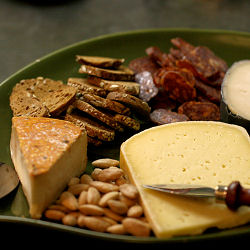 Thank goodness, we’re done with turkey. Blissfully, all of the bits and pieces made their way either into our bellies or the stock pot by early last week.
Thank goodness, we’re done with turkey. Blissfully, all of the bits and pieces made their way either into our bellies or the stock pot by early last week.
On Sunday night, we were so sick of overstuffed plates that we decided to graze. The platter pictured was our family supper: Fra’Mani salumi, Judy’s country crackers, Alfieri’s salted blanched almonds, and three cheeses: Gravenstein Gold, Matos St. George, and Midnight Moon. Every last bit was local, and all of it was delicious.
(For the play-by-play on turkey sandwiches and last week’s other local meals, check out the Flickr set.)
Of course, there’s no getting through Thanksgiving leftovers in our house without the obligatory platter of Enchiladas Suizas. This tangy south-of-the-border specialty is my favorite way to use up excess poultry, no matter the season. But my attempts to keep the dish 90% local highlighted one of the realities of the Dark Days challenge: It’s getting harder to eat as we like as the year wanes.
Unable to find tomatillos at the Ferry Plaza market, I hit up Rainbow Grocery… but theirs hailed from Mexico. I did turn up a few small specimens at the Berkeley farmers market, but they weren’t exactly plentiful. Next year, I’ll follow the lead of the Monkey Wrangler and put up tomatillos when they’re overflowing the market stalls.
But no matter the shopping conundrum, there are few things that make me happier than sitting with my clan around a table full of gorgeous Mexican comfort food. We rounded out the meal with a pan of sopa seca (Mexican rice) and a pot of heirloom beans. We even managed a small bowl of guacamole courtesy of our friend Tea, who gifted us with a trio of the season’s last avocados on her way out of town.
It’s becoming clear that locavore meals are going to require additional creativity in the coming weeks. (Is it cheating to call dried chiles a spice when you’re using them by the bagful to make enchilada sauce? Hmm…) Thankfully, we’ll be able to get our Lundberg rice and our Rancho Gordo tortillas and beans year-round. In the meantime, Rick Bayless assures us that his recipe’s just as good with canned red tomatoes as it is with fresh tomatillos; it might just be the sort of project worth a dip into our pantry stash.

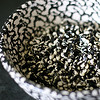
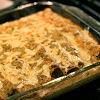


Enchiladas Suizas
– adapted from Mexico One Plate at a Time
3 pounds tomatillos, husks removed, washed to remove sticky residue
– or substitute two 28-oz cans whole tomatoes, drained
2 serrano or jalapeño chiles, stemmed
2T pork fat, chicken fat, or oil
1 medium onion, chopped
2 cups chicken or turkey broth
1/2 cup sour cream, thinned with 2T cream or milk
3 cups shredded meat, such as leftover roast chicken or turkey
2/3 cup shredded melting cheese, such as Jack
12 corn tortillas
For garnish: sliced purple onions, cilantro springs, radish slices
Roast the tomatillos and chiles under the broiler until charred and soft on both sides. Transfer to a blender along with the pan juices and puree until no large pieces remain. (If using canned tomatoes, roast the chiles in a skillet, blend them with the drained tomatoes, and proceed.)
Heat the oven to 350°F.
In a Dutch oven, heat the pork fat over medium heat. Add the onion and saute until golden. Raise the heat a notch and add the puree; cook until thickened to the consistency of porridge, 10 to 15 minutes. Stir in the broth and season to taste with salt. Cover partially and simmer 15 minutes until the sauce is still slightly soupy. Keep warm until ready to use, thinning with more broth or water as needed to keep relatively loose.

Just before using, stir the thinned sour cream into the sauce. In a large bowl, combine the meat with about 1/2 cup of the sauce, or enough to coat it without making too wet. Season to taste.
Lay the tortillas out on two baking sheets, and brush lightly both sides with corn or vegetable oil (or more pork fat). Heat in the oven for about 3 minutes, until tortillas soften enough to roll without breaking. Remove from oven and keep warm, wrapped in a towel.
Spread 1 cup of the sauce on the bottom of a 13 x 9 pan. Roll up a portion of the chicken mixture in each tortilla, then arrange the filled enchiladas in the pan in a single layer. Cover with the remaining sauce, then top with the cheese. Bake until the dish is heated through, about 15 minutes. (Depending on your oven, you may need to cover the top to prevent overbrowning, or turn on the broiler at the end to give the cheese a golden crisp.)
Serve, 2 or 3 to a plate, garnished with onion slices, radishes, and/or cilantro sprigs.
Note: Leftovers are delicious, but because the tortillas lose their shape and consistency, it’s more like a casserole on the second day.
cooking, family, locavore, Mexican, recipes
1 Comment »




Posted by Anita on 07.10.07 1:14 PM
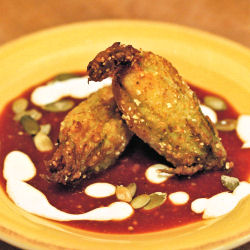 Every summer, I walk by baskets of squash blossoms at the farmers market, longing to find a use for them. Stuffing fragile flowers seemed like a tedious task for a weeknight meal, so I’d always given them a pass. But once I saw Jen’s fritters — which were in turn inspired by a course at Derrick and Melissa’s much-discussed dinner party — I knew I couldn’t put it off any longer.
Every summer, I walk by baskets of squash blossoms at the farmers market, longing to find a use for them. Stuffing fragile flowers seemed like a tedious task for a weeknight meal, so I’d always given them a pass. But once I saw Jen’s fritters — which were in turn inspired by a course at Derrick and Melissa’s much-discussed dinner party — I knew I couldn’t put it off any longer.
The basic idea seemed simple enough: Stuff the blossoms with cheese, dredge them in dairy and starch, and fry until golden. But I wanted to dress them up a bit — make them nice enough to serve as a light supper, alongside a simple salad — so I turned to my new favorite cookbook, Big Small Plates. The text of this popular title is written by Cindy Pawlcyn (of Mustards Grill fame) but the recipes themselves are largely the work of her two partners: Pablo Jacinto, the chef at Cindy’s Backstreet Kitchen, and his brother Erasto, who holds the same title at Mustards.
The book’s tapas-style approach draws inspiration from around the globe. There are plenty of straight-up California-American preparations, and Asia is well represented: A Vietnamese mini-burger salad we tried was especially delicious. But — and here I must admit to being biased — it’s the book’s Latin-influenced dishes that really shine. We’ve tackled a glorious mole casera, two batches of perfectly wonderful empanadas, and a handful of other Mexican-tinged dishes that hit the mark both in taste and in appearance.
The book’s a delight to use, aside from a few scale issues: the empanada recipe yields twice as much filling as wrappers to enclose it, and the original squash-blossom dredge made easily three times as much as I needed (I’ve corrected the proportions below). Most of the recipes serve six as an appetizer course or side dish, but many can serve as two or even four entree-size portions. Some dishes involve prepping multiple sub-recipes, but the auxiliary instructions usually revolve around simple garnishes like the lime-infused crema here. Ingredient lists can seem daunting, but the end results come together with minimal fuss. And they look as good on the plate as they do in the photos — no small compliment in the realm of chef-written cookbooks.
But back to those blossoms. I was worried that I’d waited too long between market day and making the dish: The flowers had started to wilt and the petals were sticking together. But despite their tissue-thinness, and warnings in nearly every recipe I read about the perils of tearing the flowers, the squash blossoms proved surprisingly resilient. Pulling two petals apart at the seam between them, I could split the blossom (much like you would when making a chile relleno) to remove the pollen and stuff the interior. The petal’s own natural moisture combined with the stickiness of the filling meant that I could patch the petals back together after stuffing; the batter held in any remaining leaks during frying.
It was a fiddly process, to be sure, but a highly rewarding one. Once the blossoms are stuffed, you can hold them in the fridge for a few hours. The dredging and frying comes along quite quickly after that, and if your garnishes are prepped and waiting, you’re 90 percent done with a spectacular summer appetizer. (Or one very decadent supper.)

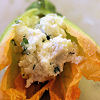
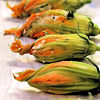
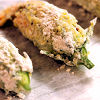

Crisp-Fried Squash Blossoms
adapted from Big Small Plates
2 ears fresh corn
1 tsp olive oil
1/2 cup grated Monterey Jack cheese
1/2 cup fresh ricotta
2 T minced cilantro leaves
—
1/4 cup cornstarch
1/4 cup cornmeal
1/4 cup all-purpose flour
1/2 tsp salt
1/4 tsp freshly ground black pepper
1/4 tsp cayenne pepper
—-
1/2 cup buttermilk
vegetable or canola oil, for frying
—
12 to 18 very fresh squash blossoms
1/4 cup toasted pumpkin seeds
1/4 cup sour cream, mixed with the juice and zest of 1/2 lime
1 cup tomatillo red-chile salsa (homemade or a good store-bought brand), warmed
Cut the kernels off the cobs. Heat the olive oil in a skillet over medium-high heat and saute the corn 2 to 3 minutes. Set aside and allow to cool, then combine with the Jack cheese, ricotta, cilantro.
Open each blossom as gently as possible, and remove the stamen. Stuff each blossom with a spoonful of the cheese-corn mixture; the amount will vary with the size of your blossoms, but don’t be afraid to stuff them well. The flowers seem delicate, but they’re surprisingly resilient. If you need more room to work, peel the flower apart at one of the ‘seams’ between the petals; you’ll be able to pinch everything back together (within reason) using the filling as glue. Leave enough room to twist each blossom shut.
Set the stuffed blossoms on a wax-paper-lined cookie sheet and place in the fridge to set. Meanwhile, combine the cornmeal, cornstarch, flour, and seasonings in a shallow bowl; put the buttermilk in another shallow bowl. Dredge each stuffed blossom, first in the buttermilk, then in the flour mixture, shaking off the excess at each step. Return them to the wax paper, then refrigerate again briefly.
Set up a cooling rack topped with two layers of paper towels next to the frying area. Add oil to a shallow skillet to a depth at least half as high as the average stuffed blossom. (I used 2 cups in a 10-inch pan.) Heat oil to 375 degrees. Slowly lower the blossoms into the pan, four or so at a time to prevent crowding, turning each over as soon as the bottom side is golden brown. It will go rather fast, but if the coating turns dark brown immediately, back off on the heat a bit; you need enough time to melt the cheese. With a spider or slotted spoon, remove the crispy blossoms to the paper towels. Repeat until all blossoms are fried.
Spoon a bit of the warmed salsa on each plate, then top with 2 or 3 blossoms. Drizzle with the lime crema, and scatter toasted pumpkin seeds for garnish.
cookbooks, cooking, farmers markets, Mexican, other blogs, recipes
6 Comments »




Posted by Cameron on 06.01.07 7:05 AM
 I felt a bit odd concocting this week’s entry, given that I had never before had an authentic sangrita — by which I mean served in a roadside shack in Mexico, or in a dark Mission District dive drawing inspiration from our friends to the South. Truth be told, I’d never even had an inauthentic sangrita — served anywhere. Given my fondness for tequila, this seemed an odd state of affairs. A post from Steve over at Rancho Gordo extolling the virtues of “a shot and a sangrita” inspired me to correct this deficiency.
I felt a bit odd concocting this week’s entry, given that I had never before had an authentic sangrita — by which I mean served in a roadside shack in Mexico, or in a dark Mission District dive drawing inspiration from our friends to the South. Truth be told, I’d never even had an inauthentic sangrita — served anywhere. Given my fondness for tequila, this seemed an odd state of affairs. A post from Steve over at Rancho Gordo extolling the virtues of “a shot and a sangrita” inspired me to correct this deficiency.
I was initially concerned that my lack of personal experience with the drink might prove to be an obstacle, but my research provided me with great comfort. As far as I can tell, if you ask fifteen sangrita aficionados to list the drink’s ingredients, you will get fifteen wildly different recipes and possibly an entertaining fistfight, depending on how many of the aficionados are in the room at the same time and how much tequila they’ve had.
Most of the sangrita recipes that I found started with some combination of tomato juice and citrus — usually orange juice. The next most common ingredient was grenadine or pomegranate juice. After that, ay dios mio, baby, just go to the vegetable market, close your eyes and point. I found instructions for chopped onion, chopped jalapeno, lime juice, chipotle powder, dried chopped ancho chile, Tabasco, cayenne pepper, chili powder, and lemon juice. I’m sure that there are even more exotic mixtures lurking in the darkness. I’m just happy that I stopped before I found anything that would require the services of an entomologist.
We tested recipes that included nearly every ingredient mentioned above, but ultimately settled on a combination of juices without a lot of additional hoo-hah. The key was achieving a balance between the tomato and fruit juice flavor — a process that required countless hours of selfless taste-testing… all in the interest of you, our faithful reader. With that done, we found that all of the other exciting additions just got in the way, added to the prep time, and made the drink grainy and unpalatable. Our winner was loosely based on a recipe from Rick Bayless’ Authentic Mexican. The beauty of this concoction is that you can easily adjust the proportions to your taste.
A few words about the ingredients: The orange juice was freshly squeezed; storebought juice will be more acidic and not as sweet. You can substitute grenadine for the pomegranate juice, but the result will be much sweeter. It’s worth the time to make your own good-quality tomato juice — all you need is a blender or food processor, a fine metal sieve, and some canned tomatoes.
Finally, skip the Tabasco, Tapatio, or other vinegar/cayenne sauces in favor of a good quality hot sauce that adds flavor as well as heat. We used Frontera Red Pepper Hot Sauce, which is, coincidentally, the bottled version of Bayless’ Chile de Arbol Hot Sauce, another recipe from Authentic Mexican. These days, the Frontera line is available in most grocery stores; you can also buy it online. Por supuesto, we got the very best results using Rancho Gordo Rio Fuego Very Hot Sauce, but we are impossibly biased.
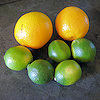
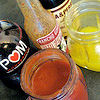



Sangrita Casada
makes four shots
4 oz. tomato juice
2 oz. orange juice
2 oz. lime juice
4 tsp. pomegranate juice
1/2 tsp. hot sauce
1/8 tsp. salt, or to taste
6-8 healthy dashes Worcestershire sauce
Combine all ingredients in a glass container, and chill well in the refrigerator. When thoroughly chilled, divide into 4 shot glasses, and serve alongside 4 shots of good-quality gold tequila, preferably reposado. Sip… first the tequila, then the sangrita.
Drink of the Week, drinks, Mexican, recipes
11 Comments »




Posted by Anita on 05.27.07 5:51 PM
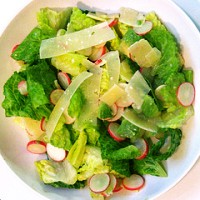 Although it’s a mainstay of American restaurants — one might even say it’s a cliché in eateries of a certain sort — the original Caesar salad was created in Mexico. The classic combination of romaine lettuce, croutons, Parmesan cheese, and a garlic-laden, egg-emulsified dressing has remained popular since its invention in the 1920s, enduring more than its share of variations throughout the years.
Although it’s a mainstay of American restaurants — one might even say it’s a cliché in eateries of a certain sort — the original Caesar salad was created in Mexico. The classic combination of romaine lettuce, croutons, Parmesan cheese, and a garlic-laden, egg-emulsified dressing has remained popular since its invention in the 1920s, enduring more than its share of variations throughout the years.
Such are the indignities that this venerable ensalada has suffered that pretty much any creamy, romaine-based salad can be called a Caesar nowadays. On the other end of the spectrum, there are purists who hold that an anchovy-free Caesar isn’t a Caesar at all (although Caesar himself used Worcestershire sauce, no little fishies at all). Adding some bacon or grilled chicken makes a Caesar suitable for a light lunch or simple supper… and that’s just the beginning of all the ways you can tinker with this highly adaptable recipe.
No doubt that sort of flexibility was what Katie at Other People’s Food had in mind when she selected Caesar salad for this month’s ‘Hay, Hay It’s Donna Day’ celebration. She even mentions Caesar wraps and Caesar pizzas — Ay, Dios mÃo, what would Señor Cardini make of that?
I set to thinking about a way to honor the salad’s historical birthplace, without going too far over into caricature — no multicolored tortilla confetti or salsa-spiked dressing, please. I played around with the basic method, adding a few south-of-the-border notes: A little chile, some avocado cubes, and a few sliced radishes in place of the croutons’ crunch.
This recipe yields a fair bit of dressing — certainly more than we ever need for just the two of us. It keeps for at least a week in the fridge, and if you prep a whole head of romaine on the night you make the dressing, the remaining lettuce will keep as long, provided you treat it right.
Here’s a trick we picked up from Alton Brown: Cut (or better yet, tear) the romaine into bite-sized pieces. Rinse and briefly soak the lettuce pieces in cold water in a salad spinner, then lift up the basket and dump out the water. Replace the basket and spin the lettuce in the usual fashion. Put half of the spun lettuce in the salad bowl, and set aside. Roll out a length of paper towels on the countertop, and sprinkle the lettuce along its length, keeping a single layer as much as possible. When you’ve laid out all the lettuce, roll up the paper towels loosely, and slide the roll into a plastic produce bag. Put the bag gently into your crisper drawer, but do not close the bag.
It’s a pretty neat trick: The paper towel wicks moisture away from the lettuce, but keeps the bag relatively humid. I’m not saying the romaine will be as good as new a week later, but it sure beats the pants off of those overpriced, half-wilted “salad in a bag” thingies.
Señor Caesar
4 cloves of garlic, unpeeled
1/2 fresh jalapeno pepper
1/4 tsp. anchovy paste, or a few dashes Worcestershire sauce
1 egg yolk
3/4 cup mild olive oil
1/4 cup lemon juice
salt & pepper to taste
—
1/2 head romaine lettuce
6 to 8 radishes
2 oz Dry Jack (or other hard cheese, such as Parmesan)
1 small, ripe avocado
Roast the garlic and chile in a small, dry skillet, turning frequently until soft and blistered. Cool briefly, then peel the garlic, and roughly chop both the chile and garlic. (Split and seed the chile before chopping, if you prefer a milder heat.) Place the chopped garlic and chiles in the mini-bowl of a food processor with the anchovy paste (or Worcestershire), and process until smooth, adding as much of the oil as needed to form a paste. Add the lemon juice and the egg yolk to the paste, and process briefly to combine. Then slowly add the remaining oil, with the processor running, until combined. Be careful not to overprocess, or you’ll get mayonnaise. Taste, and season with salt and freshly-ground black pepper.
(Alternately, you can crush the solids with a mortar and pestle and then whisk with the remaining ingredients in a medium bowl, or use an immersion blender. Either way, be sure to follow the same steps; don’t just dump everything in together or you’ll end up with a broken mess.)
Tear or cut the romaine into bite-sized pieces; wash and dry. Slice the radishes into thin rounds, discarding the stem and end pieces. Shave the cheese with a vegetable peeler into wide, thin strips. Halve the avocado, and remove the pit. With the skin on, score the avocado flesh at 1/2-inch intervals in both directions, all the way down to the skin. With a soup spoon, scoop the avocado flesh from the skin; it should separate into neat cubes.
In a large serving bowl, toss the lettuce with a few tablespoons of dressing, until just coated. Toss in the radishes, half the avocado cubes, and half the cheese. Add more dressing if needed, but be careful not to overdress. Serve on chilled salad plates, garnished with the remaining avocado and cheese.
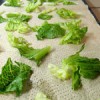
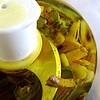


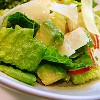
cooking, Mexican, other blogs, recipes
6 Comments »




Posted by Anita on 11.24.06 8:25 AM
 When plotting out this week’s pre-Thanksgiving meals, I decided that it had been too long since we’d enjoyed any home-cooked Mexican treats. And because I’ve already renewed the Doña Tomás cookbook three times at the library (no más renewals for me), I wanted to try one more recipe out of it.
When plotting out this week’s pre-Thanksgiving meals, I decided that it had been too long since we’d enjoyed any home-cooked Mexican treats. And because I’ve already renewed the Doña Tomás cookbook three times at the library (no más renewals for me), I wanted to try one more recipe out of it.
I picked out a chicken taco recipe — mostly on the strength of its interesting-sounding salsa — and happened upon a recipe for Michelada, a beer-based concoction, which I added to the menu.
Once I get the week’s dinners sussed out, I shuffle them around, matching each meal’s complexity to the days of the week that make the most sense. Since we were facing a short week with Thanksiving travel planned, I didn’t have a lot of wiggle room. But, consulting my trust Rancho Gordo calendar, I noticed that Tuesday, 11/20, was the anniversary of the Mexican Revolution. Perfecto!
When I went downstairs to copy the recipes out of the cookbook, imagine my amusement to find this snippet in the Michelada header notes:
Without General Don Augusto Michel, there would have been no Mexican Revolution, and no such drink as the Michelada. Actually the revolution probably would’ve still taken place, but we definitely would have been deprived of this unique libation… which is not really a beer, not really a cocktail.
And, at least anecdotally, they appear to be correct… at least about the drink’s legendary namesake. Here’s another snippet from a Mexican food distributor‘s site:
This traditional Mexican drink has been around since the days of the Mexican Revolution. A revolutionary general from San Luis Potosi named Don Augusto Michel used to visit a restaurant and he liked to drink his beer in a very unusual way. In a glass with ice, he poured lime, salt, soy sauce, pepper and picante. This speciality soon turned into a popular drink, making the restaurant famous for it. Because of that, the owner decided to baptize this speciality in honor of his creator.
Alas, I can’t seem to find any reliable references tying Don Augusto Michel to the Mexican Revolution, but I never let the truth stand in the way of a good drinking tale. So, here’s to Don Augusto’s possibly fictitious legacy, and to happy coincidence. ¡Viva la revolucÃon!
Michelada estilo Doña Tomás
coarse salt
juice of 1 lime
1-2 drops habanero hot sauce (or to taste)
1 dash Worcestershire sauce
1 pinch kosher salt
1 bottle Negro Modelo (or other dark Mexican beer)
1 lime slice, for garnish
Salt the rim of a tall glass, and fill with ice. Stir in the lime juice, hot sauce, worcestershire sauce, and salt. Pour in the beer and garnish with a lime.
beer, cookbooks, Drink of the Week, drinks, Mexican, recipes
3 Comments »




Posted by Anita on 11.21.06 12:49 PM
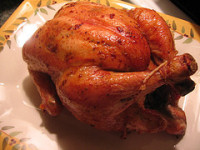 No, this isn’t a post about some Thomas Keller masterpiece. Rather, it’s an ode to a single bird that’s fed us amply for the last three days.
No, this isn’t a post about some Thomas Keller masterpiece. Rather, it’s an ode to a single bird that’s fed us amply for the last three days.
We’ve gotten into the habit of buying a chicken from the folks at Hoffman each Saturday, and then roasting it up for Sunday dinner. Sometimes we put it on the rotisserie, sometimes it ends up as Zuni Roast Chicken, still others we spatchcock it and stick it under the broiler.
The thing about these Hoffman birds is that they’re normal size, even perhaps a little smallish (which is how I like them, anyway). But the skin is so tasty, and the meat so satisfying, that we quite happily feast on them for days, without complaint. Not a scrap goes to waste.
This weekend, we simply stuffed some rosemary-salt butter under the skin, trussed the legs, and set the bird in the oven on 375º for about an hour and 20 minutes. The bird cooked faster than I expected, catching me off-guard for side dishes. I set the roasted bird aside, and Cameron made a simple salad using baby greens we’d picked up at the market.
Meanwhile, I boiled a half-box of linguine, defatted the drippings, added some stock and wine, and reduced it to a saucy consistency. When the pasta was still al dente, I tong’ed it into the roasting pan, tossed it in the sauce for a quick simmer, and popped it on the plate with a piece of the chicken on top. It was good enough for company, if I do say so myself.
The next morning, I turned some leftover breast meat into my favorite chicken salad, and smeared it between two slices of Acme pain de mie — heaven. And then, for dinner, we tucked some more shredded meat and cheese into Rancho Gordo tortillas and made tacos dorados from the Doña Tomás cookbook.
Am I sick of this chicken yet? Not on a bet. This morning, I finished off a stale bag of tortilla chips with some of the leftover salsa from last night’s dinner, sprinkled on a little cheese and the last of the breast meat… voilá: Chilaquiles for breakfast. And I’m having the leftover tacos for lunch. If I wasn’t heading out of town, you can bet that the carcass and back meat would be destined for soup later in the week, too.
cookbooks, cooking, farmers markets, Mexican
6 Comments »




 The San Francisco cocktail circuit is a pretty cozy scene. It’s not just that bartenders pick up shifts at three or four different bars or restaurants in as many nights, although that helps. It’s more that for some reason, every now and then, a somewhat obscure cocktail will simultaneously capture the imaginations of multiple menu-writers. Suddenly you see the darned thing everywhere.
The San Francisco cocktail circuit is a pretty cozy scene. It’s not just that bartenders pick up shifts at three or four different bars or restaurants in as many nights, although that helps. It’s more that for some reason, every now and then, a somewhat obscure cocktail will simultaneously capture the imaginations of multiple menu-writers. Suddenly you see the darned thing everywhere.
























 Getting the house — and the fridge — ready for our 10-day Christmas absence was an enormous pain in the ass. Truthfully, I enjoy the puzzle of combining fresh food and freezer fodder to make reasonably coherent meals, but sometimes this happens at the expense of our 90%-local
Getting the house — and the fridge — ready for our 10-day Christmas absence was an enormous pain in the ass. Truthfully, I enjoy the puzzle of combining fresh food and freezer fodder to make reasonably coherent meals, but sometimes this happens at the expense of our 90%-local 











 Every summer, I walk by baskets of squash blossoms at the farmers market, longing to find a use for them. Stuffing fragile flowers seemed like a tedious task for a weeknight meal, so I’d always given them a pass. But once I saw
Every summer, I walk by baskets of squash blossoms at the farmers market, longing to find a use for them. Stuffing fragile flowers seemed like a tedious task for a weeknight meal, so I’d always given them a pass. But once I saw 




 I felt a bit odd concocting this week’s entry, given that I had never before had an authentic sangrita — by which I mean served in a roadside shack in Mexico, or in a dark Mission District dive drawing inspiration from our friends to the South. Truth be told, I’d never even had an inauthentic sangrita — served anywhere. Given my fondness for
I felt a bit odd concocting this week’s entry, given that I had never before had an authentic sangrita — by which I mean served in a roadside shack in Mexico, or in a dark Mission District dive drawing inspiration from our friends to the South. Truth be told, I’d never even had an inauthentic sangrita — served anywhere. Given my fondness for 




 Although it’s a mainstay of American restaurants — one might even say it’s a cliché in eateries of a certain sort — the original
Although it’s a mainstay of American restaurants — one might even say it’s a cliché in eateries of a certain sort — the original 




 When plotting out this week’s pre-Thanksgiving meals, I decided that it had been too long since we’d enjoyed any home-cooked Mexican treats. And because I’ve already renewed the
When plotting out this week’s pre-Thanksgiving meals, I decided that it had been too long since we’d enjoyed any home-cooked Mexican treats. And because I’ve already renewed the  No, this isn’t a post about some Thomas Keller masterpiece. Rather, it’s an ode to a single bird that’s fed us amply for the last three days.
No, this isn’t a post about some Thomas Keller masterpiece. Rather, it’s an ode to a single bird that’s fed us amply for the last three days.